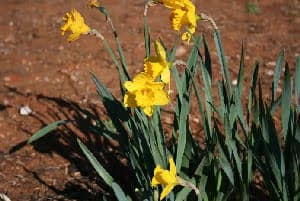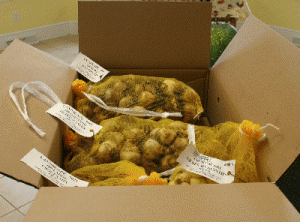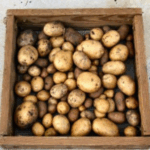That’s not a typo. We bought 430 spring bulbs to plant around Seven Oaks.
Many years ago, I got a book out of the library filled with landscaping ideas. One glossy color photo captured our attention. It showed an orchard of apple trees. Planted among the floweirng apples trees were daffodils, grape hyacinth, crocus…a living carpet of yellow, purple, white, buzzing with bees while the dainty pink apple blossoms swayed above.
We were absolutely captivated by that image, and we wanted to recreate it when we finally could. Now’s our chance…

Last year, I planted just about a dozen King Alfred bulbs in the orchard. A few came up. This photo is from last year (the one above is from Morguefile – but what we aspire to!)
According to the book, the spring flowers flourish in the orchard. Sunlight nurtures them until the trees leaf out, and by the time the grass grows high enough to need mowing, the bulbs are finished for the year.
So that is what was are doing here.
We bought 100 King Alfred Daffodils, and 100 of a professional landscaping mix for naturalizing. We bought 100 crocus and another 100 grape hyacinths.
And the remaining 30?
I love tulips. I can’t be without them. Fifteen mixed pastel tulips will be planted near the deck, alongside 15 mixed color hyacinths for their heavenly smell.
The deer love to graze in our orchard, and ever night, the mama deer with the crooked leg and her two almost-grown fawns graze among the apple trees. We picked the daffodils for the wide open areas for the most important reason: they’re deer resistant!
Now on to planting them….I wonder how long that’s going to take?!






I’m in a similar situation, bought a lot of bulbs… So far I’ve got through almost 200 of them with plenty more still to go… Not sure if I’ll manage it and no doubt will give some away!
Good luck with your planting 🙂
A great naturalizer are the Tete-a-Tete daffodils. I bought a few four packs one year and within three years I had over 10 times the amount that I started with! Grape hyacinths and squill are another great reproducer.
I usually plant close to 700 bulbs every year. They jump into my shopping cart every fall! How can I say no?
Four hundred are too many when you are planting, too few when they bloom. I haven’t missed a year adding bulbs since 1994.
To play around with 400 bulbs must be interesting, visualising the final look while putting them down…, and have to wait months to enjoy the beauty!.. Sounds great. ~bangchik
Nell Jean, I’d love to see pictures of your garden. Wow. I can just imagine the bulbs! My goal is to add one or two iris every year 🙂 I’m obsessed with iris and now I bought an encyclopedia of iris. Look out….
Bangchik, I’ll definitely post photos when they bloom – should be next April. Only 6 months away LOL!
Thanks for posting a comment.
You can see a few of my blooming bulbs from previous years by clicking on my name on this comment.
They bloom in sequence, so the show is never as grand as if there was one or two cultivars that all bloomed together, but it extends the season to have early, mid and late bloomers.